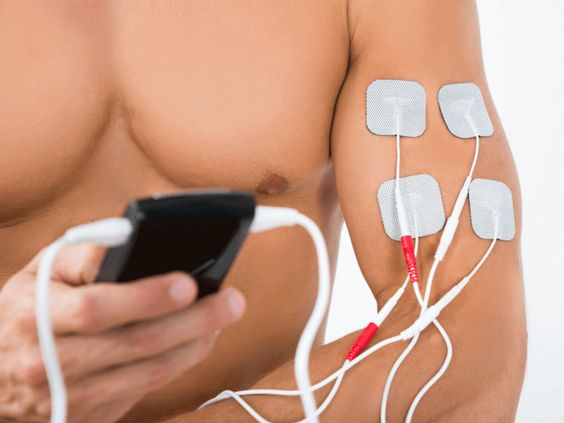Can Electrical Stimulation Help Build Muscle?
Asenqua Tech is reader-supported. When you buy through links on our site, we may earn an affiliate commission.

Electric muscle stimulation (EMS), commonly known as e-stim, has become increasingly popular for rehabilitation, pain relief, and improving athletic performance. Even though Bruce Lee was an early user of this technique, advancements in technology have made EMS more accessible in settings like homes, gyms, rehab centers, and sports labs.
For those passionate about bodybuilding, the pressing question is: Can EMS accelerate your journey to a more muscular, stronger, and leaner physique?
This article delves into whether EMS can genuinely aid muscle building, offering a thorough exploration of its advantages and limitations.
What is EMS and How Does It Work?
EMS, or electrical muscle stimulation, is a technique that uses electrical currents to stimulate muscle contractions. When using EMS for muscle growth, electrodes are placed on the skin above the targeted muscles. These electrodes then deliver low-level electrical pulses that mimic the signals sent by the brain to initiate muscle contractions during physical activity.
The electrical pulses from EMS activate motor nerves, causing the muscle fibers connected to these nerves to contract. This contraction mimics the natural process that occurs during exercise, engaging the muscles and potentially leading to improvements in muscle strength and growth.
While scientists are still figuring out all the details, they have some ideas about how EMS benefits muscles. One way is by causing a bit of controlled damage to muscle tissue, similar to what happens during regular exercise. This seems to influence the production of proteins linked to muscle growth. Moreover, EMS might have neuromuscular benefits, meaning it could enhance muscle strength by making changes in the central nervous system.
Here’s a fascinating tidbit: as we age, the connections between motor nerves and muscle fibers (known as neuromuscular junctions) tend to deteriorate, contributing to a loss of muscle strength. EMS might help counteract this by activating sensory neurons that send information about muscle movements back to the central nervous system. However, this aspect is more relevant to the rehabilitation of people with motor control loss, like those recovering from a spinal cord injury.
While EMS can provide a level of muscle stimulation similar to physical activity, it’s essential to note that it’s not a complete substitute for regular exercise. Rather, it can complement a workout routine by offering additional muscle engagement and aiding in muscle recovery.
For example, you can use a home-use EMS device such as Vital Flex Core when you have no time to go to the gym. It might be helpful for stimulating muscle growth.
What Does the Research Say?
The challenge facing the EMS fitness industry is that research on its effectiveness presents a mixed bag of results. Even the positive studies tend to throw in words like “might,” “could,” or “may,” leaving a bit of uncertainty in the air.
A report from 2011 acknowledged that EMS “has been acknowledged” for contributing to “significant improvements in strength.” However, it quickly followed up by stating that these changes are still “ambiguous,” “poorly understood,” and “require more study.”
An article from earlier this year echoed the sentiment that the jury is still deliberating.
The US Food & Drug Administration suggests that when used for fitness, EMS devices “may be able to temporarily strengthen, tone or firm a muscle” but emphasizes the need for accompanying exercise and diet.
On a cautionary note, it warns against unregulated devices, which could potentially lead to “shocks, burns, bruising, skin irritation, and pain.”
So, while there’s the promise, it’s crucial to proceed with caution and consider the bigger picture of fitness alongside EMS use.
The Effectiveness of EMS in Muscle Building
The burning question for bodybuilding enthusiasts is whether EMS can accelerate progress toward a bigger, stronger, and leaner physique.
In the following section, we’ll look at more studies to explore the roles of EMS in body building:
Untrained Older Adults
When older folks who weren’t into exercise tried out EMS, some good things happened. In one study, 16 seniors did EMS knee extensions at home for 24 sessions and ended up with better mobility, thicker muscle fibers, and improved markers for muscle function and growth. Similar positive vibes were found in other small trials. However, the overall proof isn’t strong enough to say for sure.
Ameta-analysis looking at 16 others, mostly middle-aged or older adults who weren’t workout buffs, showed EMS led to more muscle mass and strength, though the results weren’t the same in every study.
Another study in 2020, checking out experiments with control groups, didn’t see a big benefit for EMS but stressed the need for more info to make solid conclusions.
Fit, Active Adults
When people use EMS during their workouts, lots of studies show potential benefits. But here’s the twist: the results aren’t always the same because everyone’s doing EMS in different ways.
The strength, frequency, and time of the electrical pulses, along with how hard and what type of exercise you’re doing, make it tricky to pin down. Some studies didn’t have a comparison group, so the mind’s power (the placebo effect) might have had a say.A meta-analysis comparing EMS and regular strength training didn’t find much difference.
So, while EMS could help those who can’t go all out in their workouts, it might not bring any extra oomph to an already awesome routine. Just a heads-up: too much EMS might push you into overtraining territory, and in rare cases, it could even cause serious conditions like rhabdomyolysis.
Weight Loss
The research on EMS and weight loss is limited but shows some potential benefits. EMS gets your muscles working and burns calories during and after the session. For example, one study found that if you use EMS on your abs, glutes, quads, and hamstrings, you might burn an extra 75 calories per hour. But, compared to a brisk walk that burns over 200 extra calories per hour, it’s not as much.
Studies looking at non-athletic adults found a link between EMS and reduced body fat, but it wasn’t a strong connection statistically. So, while EMS could be a helpful addition to your weight loss plan, it’s probably not going to replace your regular strategies entirely.
The Bottom Line
While EMS shows promise as an enhancer of traditional strength training, it is important to recognize its limitations. EMS cannot replace weightlifting and should be seen as a complementary tool rather than a standalone solution for muscle building.
When used in conjunction with weightlifting, EMS has the potential to minimize injury risks and provide more complete activation of working muscles, aiding in hypertrophy and strength gains.






